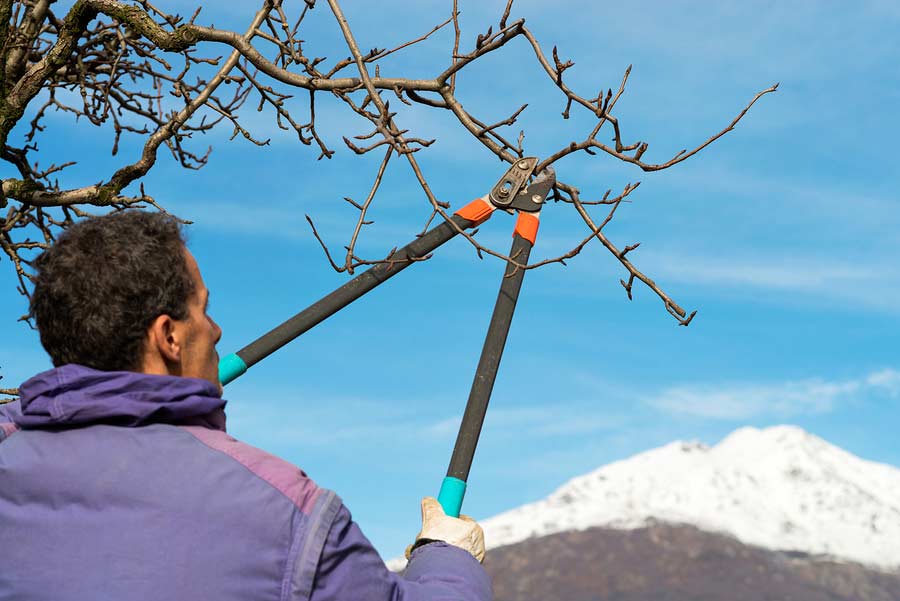The Guide to Tree & Shrub Pruning In Winter
As winter approaches, there are some shrub and tree pruning jobs that are best done during the coldest months of the year. Generally speaking, your deciduous (their leaves drop off in fall) bushes and trees need trimming in the winter. Since deciduous trees lose their leaves in winter, you can see clearly what branches need to go and which ones can stay.
However, not all trees and bushes need pruning. To successfully take care of your woody plants in winter requires that you know which ones to trim and which ones to leave alone.
Pruning Trees and Shrubs
Basically, you can prune trees and shrubs that are deciduous as well as some fruit trees. However, maples and magnolias don’t want to feel your secateurs on their limbs. The only tree pruning you need to do to maples and magnolias is to remove any dead, diseased or insect-infested limbs. If not, heavy winds will lob off those dead branches for you, endangering you and your family.
Also, you want to get rid of any diseased or insect-ridden branches on maples and magnolias, so the disease or infestation doesn’t go farther than the injured limb.
Further reading for winter garden care
5 landscape ideas to prevent flooding
Getting the garden ready for winter
Dead leaves smothering your lawn this autumn?
Selective Pruning
Selective pruning is a form of pruning trees and bushes that respects the tree’s natural shape, but it also allows for air to circulate and sunlight to penetrate these woody plants. However, some homeowners and tree care companies believe in topping trees. Tree topping leaves your trees unbalanced and ugly. Plus, you’ll notice spouts rather than branches growing on the top of the tree.These spouts are fragile limbs that could break off during a severe storm. So, tree topping not hurts the tree, but it also weakens it.
Trees: For early spring flowering trees, you want to trim them in late August. Below is a list of deciduous trees, including early bloomers that need winter pruning:
Ash
Beech
Dogwood
Eastern ninebark
Elm
Gingko
Locust
Smoke tree
Oak
Tulip
Walnut
Willow
Shrubs: Again, your shrubs benefit from selective pruning too. First you need to remove all dead and diseased limbs. Then you can trim the shrub back to its natural shape. Here are some common bushes to prune over the winter:
Abbotswood
Buddleia
Bush roses
Hops
Hydrangeas
Mock orange
Perennial sweet pea
Spiraea japonica
Summer clematis
Roses
The most popular shrub in Kiwi gardens is the rose. So, it’s only appropriate to talk about the rose’s winter pruning needs. It’s safe to prune most roses over the winter because New Zealand roses bud on new bark rather than old bark. You want to cut above the buds and trim off old, dead or diseased canes. It’s recommended that you prune roses from mid-June through August unless you live in an area that gets very cold. Then you should wait to trim them in August.
Pruning Fruit Trees
Most fruit trees need pruning in the early spring or fall. And yet, there are two fruit trees as well as two fruit-bearing, woody vines that need winter pruning:
1. Apple and pear trees: These two fruit trees need pruning every winter to ensure a superb crop the following summer. Matter of fact, pears only provide a yield every other year. So, when you correctly prune this tree, you’ll find that it produces an abundant crop of pears in the second season.
2. Grapes and kiwi fruit: Even though grapes and kiwis grow on vines, it’s important to mention them in a shrub and tree trimming article. These fruits need to be pruned back every winter, so they continue to produce plentiful crops. Your goal is to cut back these vines, leaving only three to five buds per plant.
Finally, it’s vital to remind you of which fruit trees and woody vines that don’t need winter pruning. If you would trim them this winter, you’d be opening up these plants to disease and freezing temperatures.
Almonds
Blueberries
Cherries
Chilean guavas
Citrus trees
Feijoas
Figs
Nectarines
Olives
Peaches
Your trees and shrubs deserve the best care, and that includes trimming jobs. If you want to avoid the hassle of tree pruning this winter, make sure you hire a professional operator from Crewcut. Check with your local Crewcut operator to see if they are equipped are trained to properly prune trees and shrubs—preserving the woody plants’ natural shape and taking only off enough to keep them healthy.





